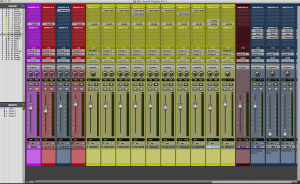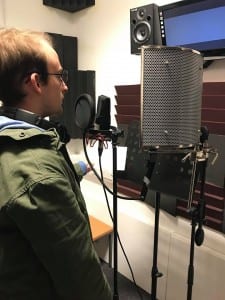LO2: Create audio material for film makers through professional collaboration.
LO3: Apply professional Pro-Tools editing and mixing techniques in a Audio Post Production situation for a film project.
For this particular film, we were not involved within a field recording sense. Due to this, we were working with audio files that were not recorded by us. This raised some issues in regards to sound quality as a lot of the interviews were done over Skype and recorded by just sticking a microphone in front of a laptop speaker. An immediate issue with is Skype hasn’t got the best overall quality as it relies on wifi. This meant that a lot of interview recordings were quite muffled in places.
The first call of action in regards to this was using some of the advise put forward by Jay Rose and applying some form of EQ to the track in an attempt to remove the fuzz that was audible throughout the recording. The involves bringing up a 7 band EQ and first, trying to find where the hum was most prominent. This turned out to be at around 60Hz, it was clear though that there was still an obvious hum so I proceeded to find another frequency where the hum was prominent and put the gain way down. It was however still slightly prominent so I rolled off the low end frequencies and that just about sorted it out to an audible level. Editing interviews so they were clear and consistent proved to be where most of the post production time on this film was spent;

As seen within this screenshot here, a lot went into editing the dialogue so that it was both consistent with other pieces of the film and also, to remove various unwanted sounds such as knocks, plosives and hums. The reason why we focused so heavily within the dialogue tracks is there various industry professionals who I have researched such as Jay Rose and Bobby Owinski often state the importance of dialogue in comparison with the rest of the film.
Towards the back end of the overall edit, I would discover that a lot of the recorded narration was incredibly plosive. Upon hearing this I initially set out to remove these or at-least attempt to reduce. Firstly, I singled out the specific letters in which the plosive could be heard, turned it down and cross-faded it with the rest of the track. Whilst this worked to a degree; it was evidently still quite noticeable. After then spending time working with de-esser and high pass filters, I thought it’d be beneficial to re-recording the narration as the director(who narrated the film), was in later that day. The reason behind doing this was that I felt that I was going around in circles in attempt to salvage something that would never be 100% perfect and according to Jay Rose, it is important to know when to settle with an edit.

This was a simple session but we were able to quickly get it done due to efficient planning such as setting up the microphone at a 5 degree axis and getting the line of dialogue printed for the director.
Leave a comment